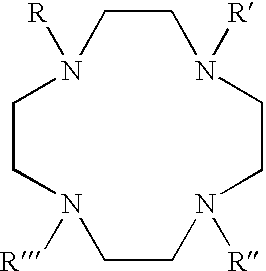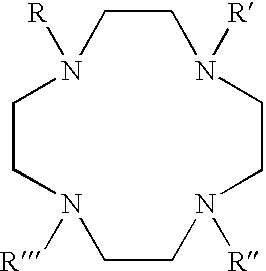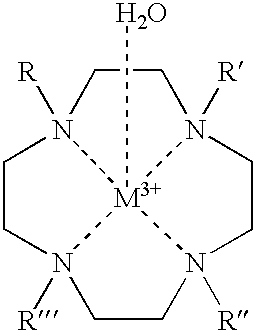Paramagnetic metal ion-based macrocylic magnetization transfer contrast agents and method of use
a macrocylic magnetization and contrast agent technology, applied in the field of contrast agents, can solve the problems of slow water exchange rate, difficult to avoid off-resonance saturation of bulk water or tightly protein-bound water in tissue samples, and limited use of cas in living subjects
- Summary
- Abstract
- Description
- Claims
- Application Information
AI Technical Summary
Problems solved by technology
Method used
Image
Examples
experiment 1
[0062] A first experiment, examined the life times at 298.degree. K, .tau..sub.M.sup.298, of water molecules bound to various lanthanide-macrocylic complexes of the present invention, and having the general formula, Ln(1).sup.3+, where the four pendent arms R, R', R" and R"' are all ethyl-acetamidoacetate (i.e., LnDOTA-4AmCE.sup.3+), as depicted below: 4
[0063] As illustrated in FIG. 3, .tau..sub.M.sup.298 is strongly dependent on the radius of the central lanthanide ion. The plot shows the .tau..sub.M.sup.298 measured for a series of Ln(1).sup.3+ complexes in acetonitrile plus 2-4% water versus the Ln.sup.3+ ionic radii. Individual .tau..sub.M.sup.298 values were obtained by fitting the temperature dependent .sup.17O NMR bound water line widths according to standard exchange theory. In a separate series of experiments, it was found that .tau..sub.M.sup.298 was about 2-fold shorter when pure water was the solvent. Because the bulk water .sup.17O resonance of Yb(1) solution was relati...
experiment 2
[0065] In a second experiment, MT profiles, also known as Z-profiles or CEST profiles, were obtained for lanthanide-macrocylic complexes of the general formula Ln(1).sup.3+. FIGS. 4-7 show representative spectra in the absence of saturation (bulk water peak at 0 ppm truncated to make the bound water peaks more visible) and MT profiles for Eu(1).sup.3+, Pr(1).sup.3+, Nd(1).sup.3+ and Yb(1).sup.3+ complexes, respectively, all measured at 4.7 T. All experiments were conducted using aqueous 62.5 mM Ln(1).sup.3+ adjusted to neutral pH and about 22.degree. C., using an saturation duration time of 1 s, RF power of 16 db, and a 2.5 cm surface coil. FIGS. 4, 5 and 6 illustrate that Eu(1).sup.3+, Pr(1).sup.3+ and Nd(1).sup.3+ all display strong MT properties when a saturating RF pulse is directed at their bound water positions of +50, -45 and -36 ppm, respectively (with bulk water at 0 ppm). Among these three complexes, Eu(1).sup.3+, shown in FIG. 4, had the greatest effect when the saturatin...
experiment 3
[0066] A third series of experiments was performed to examine the ability of lanthanide-macrocylic complexes of the general formula Ln(1).sup.3+ to enhance MRI contrast by MT. FIGS. 8 and 7(21) demonstrate image contrast obtained using aqueous solutions of 62.5 mM Eu(1).sup.3+ and Nd(1).sup.3+, respectively. The inner vial contains 62.5 mM Eu(1).sup.3+ or Nd(1).sup.3+ at neutral pH, while the outer vial is pure water. T.sub.1-weighted spin-echo images (TR / TE=500 / 18 ms, 256.times.256 data matrix) were obtained at about 22.degree. C. and a field strength of 4.7 T. MT was achieved by applying RF irradiation for 1 s, with a power of 16 db by using a 2.5 cm surface coil. FIG. 8 shows images obtained with no saturation (left, nosat), saturation at +9800 Hz (middle, Satp) at the resonance frequency of Eu.sup.3+-bound water, saturation at -9800 Hz (right, satn), and the corresponding difference images. FIG. 9 shows analogous images for a phantom with no saturation (left, nosat), saturation ...
PUM
| Property | Measurement | Unit |
|---|---|---|
| chemical shifts | aaaaa | aaaaa |
| proton chemical shifts | aaaaa | aaaaa |
| proton chemical shifts | aaaaa | aaaaa |
Abstract
Description
Claims
Application Information
 Login to View More
Login to View More - R&D
- Intellectual Property
- Life Sciences
- Materials
- Tech Scout
- Unparalleled Data Quality
- Higher Quality Content
- 60% Fewer Hallucinations
Browse by: Latest US Patents, China's latest patents, Technical Efficacy Thesaurus, Application Domain, Technology Topic, Popular Technical Reports.
© 2025 PatSnap. All rights reserved.Legal|Privacy policy|Modern Slavery Act Transparency Statement|Sitemap|About US| Contact US: help@patsnap.com



